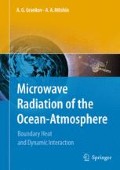Abstract
Some possibilities of using the module of remote sensing the atmosphere temperature and humidity (MTVZA) of the Russian meteorological satellite METEOR-3M and American DMSP SSM/I radiometers in studies of the ocean-atmosphere heat and dynamic interaction are discussed. The results of imitation of the MTVZA brightness temperatures based on the data of oceanographic, meteorological, and aerologic measurements in the North Atlantic from vessels (experiment ATLANTEX-90) and their comparison with the actual measurement data derived from the F-08 (DMSP) SSM/I radiometer are presented. The comparison was made at the wavelengths 1.35 cm, 1.6 cm, and 8 mm, which are similar for both radiometers and give a reliable information on the integral water vapor content in the atmosphere and liquid water content in the clouds, as well as the vertical turbulent heat and momentum fluxes at the ocean-atmosphere boundary. Comparison of data obtained from the radiometer MTVZA with the data of measurements from the radiometer SSM/I of the DMSP satellite F-13 (at the wavelength 1.35 cm) in April and May, 2002 was done for the areas of the North Atlantic characterized by a strong variability of hydrometeorological parameters and an intensity of natural MCW radiation.
Access this chapter
Tax calculation will be finalised at checkout
Purchases are for personal use only
References
Armand NA, Tichsenko JuG, Ablyazov VS, Khaldin AA (2008) Satellite L-microwave radiometers. In: Actual problems of the Earth Remote Sensing from Space (Collected Papers), Poligraph Service, pp 139-145
Borges A, Solana A, Plaza et al (2000) The MIRAS Demonstrator Pilot Project. In: Proceedings of IEEE IGARSS’2000, 24-28 July, Honoluly (oral report)
Bunker AF (1976) Computations of surface energy flux and annual sea-air interaction cycles of the North Atlantic Ocean Mon. Weather Rev 96:1122-1140
Cherny IV, Raizer V Yu (1998) Passive microwave remote sensing of oceans. Wiley, UK, p 300
Cherny IV, Chernyavsky GM, Gorobetz NN et al (1998) Satellite Meteor-3M microwave radiometer MTVZA. In: Proceedings of International Symposium on Remote Sensing (IGARSS’98): Collected Papers, Seattle, USA, pp 556-558
Cherny IV, Chernyavsky GM (2001) Combined Optical-Microwave Imager/Sounder MTVZA-OK. In: Proceedings of International Symposium on Remote Sensing (IGARSS’2001): Coll. Papers. Sydney, pp. 2016-2018
Defense Meteorological Satellite Program (DMSP) (1997) Satellite source/Platform document. NOAA Satellite Active Archive
Dubach L, and C. Ng (1988) NSSDC’s Compendium of Meteorological Space Programs, Satellites, and Experiments, March 1988
Falcone VJ, Griffin MK, Isaacs RG et al (1992) DMSP F11 SSM/T-2 calibration and validation data analysis. Phillips Laboratory, Hanscom Air Force Base, MA
Grankov AG, Milshin AA (2001) Evaluation of usefulness of the SSM/I data for study of climatic parameters of the ocean and atmosphere in the North Atlantic. Issledovanija Zemli iz kosmosa 5:70-78 In Russian
Grankov AG, Milshin AA, Shelobanova NK (2001) Specific features of the subpolar hydrological front from microwave radiometric satellite data. Russian Meteorol Hydrol 8:34-40
Hollinger PH, Peirce JL, Poe GA (1990) SSM Instrument evaluation. IEEE Trans Geosci Remote Sens 28:781-790
Kawanishi T, Sezai T, Ito et al (2003) The Advanced Microwave Scanning Radiometer Radiometer for the Earth Observing System (AMSR-E), NASDA’s Contribution to the EOS for Global Energy and Water Cycle Studies. IEEE Trans Geosci Remote Sens 48:173-183
Kondrat`ev KJa, Buznikov AA, Pokrovskii OM (1992) Global ecology: remote sensing. atmosphere, ocean, space - “Razrezy” Program, VINITI, Moscow 14:145-165 (in Russian)
Nakonechny VP, Pantzov VJu, Prokhorov JuN (2004) Optical/microwave scanner/sounder MTVZA-OK. In: Actual problems of the Earth Remote Sensing from Space (Collected Papers), issued annually. Poligraph Service, pp 139-145 (in Russian)
Njoku EG (1982) Passive microwave remote sensing of the Earth from Space. IEEE Proc 70:728-750
Njoku EG, Rague B, Fleming K (1995) Nimbus-7 scanning multichannel microwave radiometer (SMMR): brightness temperature data (SMMR level 1B pathfinder). JPL Publication, Jet Propulsion Laboratory, Pasadena, CA
MTPE EOS Reference Handbook (1995) Asrar G. and Greenstone R. (eds). EOS Project Science Office, NASA/GSFC, 277 pp
Remote Sensing Applications (1998) Putting NASA’s Earth science to work. - Raytheon Systems Company, Mariland 1-36
Shilin BV, Tronin AA (1995) First sympozum (advanced earth observing satellite - ADEOS). Issled Zemli iz kosmosa 5:117-119 In Russian
Special Sensor Microwave Imager (SSM/I) User’s Interpretation Guide UG32268-900, Rev C 29 November 2000
Special Sensor Microwave Imager and Sounder (SSMIS) Antenna brightness temperature data record (TDR) (2007). Calibration and validation user manual. Center for Satellite Applications and Research NOAA/NESDIS
Tadepalli K (1994) SSM/T-2 Level 1b interface control document NOAA/NESDIS: Suitland, MD, 11 July
Vazhnik TP, Chistyakova EA (1989) A method for forecasting the air-sea anomalies in the Northern Atlantic and the European territory of the USSR in western Siberia and North Kazhakstan using the water temperature in active zones of the North Atlantic Search Earth from Space. Tr GidrometCenter 303:127-134 In Russian
Author information
Authors and Affiliations
Corresponding author
Rights and permissions
Copyright information
© 2010 Springer Science+Business Media B.V.
About this chapter
Cite this chapter
Grankov, A., Milshin, A. (2010). Effectiveness of the Satellite MCW Radiometric Means of Studying the Air–Sea Interaction. In: Microwave Radiation of the Ocean-Atmosphere. Springer, Dordrecht. https://doi.org/10.1007/978-90-481-3206-5_5
Download citation
DOI: https://doi.org/10.1007/978-90-481-3206-5_5
Published:
Publisher Name: Springer, Dordrecht
Print ISBN: 978-90-481-3205-8
Online ISBN: 978-90-481-3206-5
eBook Packages: Earth and Environmental ScienceEarth and Environmental Science (R0)

